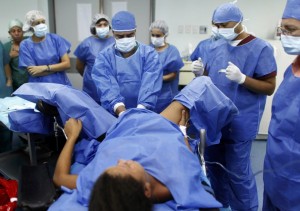 School of Architecture and Urban Planning
School of Architecture and Urban Planning
BIRTH ENVIRONMENTS ~ Emerging Trends and Implications for Design
Alice Lerman, B.A., J.D., M. Arch ~ University of Wisconsin; School of Architecture and Urban Planning
A Project supported by the American Institute of Architects and the American Hospital Association Fellowship ~
pages 7 & 8:
“Obstetrics, over the past decade, has achieved renewed status among hospital departments.
The impetus for this development has been the advent of competition among hospitals as a result of changing health care economics and the acceptance of health care marketing as an ethical business activity.
(“Innovations in Obstetric Design” Hospital Administrations Currents, 1986, 30 (3): 9-14)
Obstetrics is now considered to be the service leader in establishing patient loyalty to the institution”.
Innovative maternity programs can increase the patient volume in other areas, through the woman’s influence. Since women tend to decide where the family will go for medical care (in 70% of families say some researchers), loyalty won through innovative obstetrics programs transfers to other patient areas.
page 15:
Marketing of its facility is very important to the hospital. A facility that is designed to be inviting, comforting and attractive …..will increase consumer response and improve its image and visibility in the community. Studies show that a positive hospital experience for maternity care leads to continued usage of the medical facility by the family consumer group.
It is estimated by Ross Planning Association that 10% to 28% in operating costs can be saved with the LDRP system over the traditional design. The programs below show that LDRP units do require more square footage than traditional programs. Initial equipment and construction costs can be offset by a decline in operating costs and an increase in revenues due to volume changes.
(Hospital Administration Currents, vol. 30, no 3, 1986)
page 34:
Women in today’s society are increasingly aware and sensitive to the fact that they compose a significant group of health care users. Medical facilities are competing for a greater market share of women consumers.
There is evidence that once a woman has a positive experience in the hospital she chooses for maternity care, she and her family will usually return to the same hospital for future medical needs.
A separate women’s health care facility is the optimal setting for obstetric care. This gives a woman a *sense of importance and dignity* as she faces the medical establishment. A distinct women’s medical center could be connected to the main hospital by physical proximity and or a sheltered bridge or tunnel for easy access to centralized labs or common services.

Classic hospital birth position with the mother laying flat on her back in lithotomy position, legs in stirrups, surrounded by hospital employees and medical students in scrub suits, caps, and masks.
Editorial Comment: Note the article talks about women having a “sense” of importance, which is not the same thing as having importanc
Actually having importance and dignity would mean having legitimate choices, including the ability to choose where you want to give birth and who will be present during her labor and birth
 This includes the right to say “no” to elective inductions or Pitocin augmentation of labor, the use of continuous EFM, IVs (versus simply drinking water) and not being tethered to one’s labor bed. Having importance and dignity in regard to normal childbirth means being able to move around at will, walk, squat, and generally be in charge of one’s own physical body during the biological process of normal labor, and spontaneous birth.
This includes the right to say “no” to elective inductions or Pitocin augmentation of labor, the use of continuous EFM, IVs (versus simply drinking water) and not being tethered to one’s labor bed. Having importance and dignity in regard to normal childbirth means being able to move around at will, walk, squat, and generally be in charge of one’s own physical body during the biological process of normal labor, and spontaneous birth.
